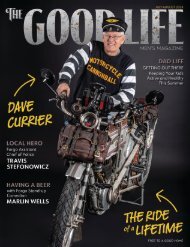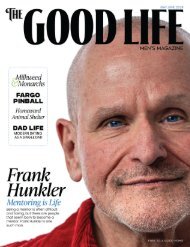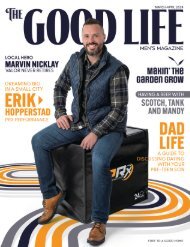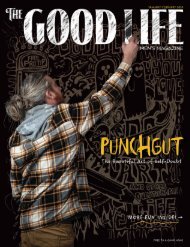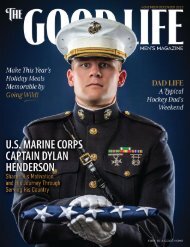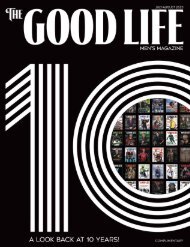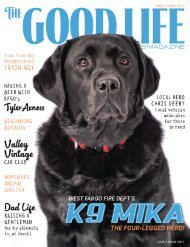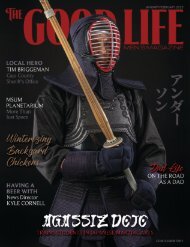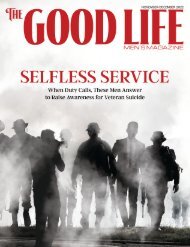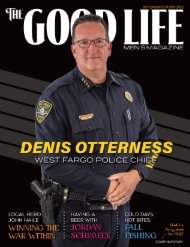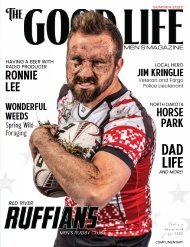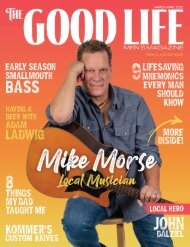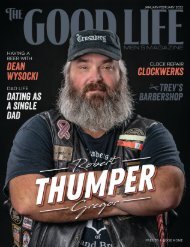The Good Life – July-August 2017
Featuring WDAY Reporter Kevin Wallevand - Fargo's most famous storyteller. Local Hero - Navy Veteran, Shane Tibiatowski. Having a Beer with Dilworth Mayor - Chad Olson and more in Fargo Moorhead's only men's magazine.
Featuring WDAY Reporter Kevin Wallevand - Fargo's most famous storyteller. Local Hero - Navy Veteran, Shane Tibiatowski. Having a Beer with Dilworth Mayor - Chad Olson and more in Fargo Moorhead's only men's magazine.
Create successful ePaper yourself
Turn your PDF publications into a flip-book with our unique Google optimized e-Paper software.
CELEBRATING FOUR YEARS OF THE GOOD LIFE!<br />
4 YEARS!<br />
THE GOOD LIFE<br />
• Est. in <strong>July</strong> 2013<br />
• Founded, published<br />
and distributed by<br />
Urban Toad Media<br />
175,000<br />
We've delivered<br />
TOP 3 ONLINE ISSUES<br />
Most Read and Most Shared<br />
• Steve Stine<br />
• Timothy Johnson<br />
• Jay Thomas<br />
MALE READERS<br />
copies!<br />
ALWAYS AVAILABLE AT<br />
HORNBACHERS •<br />
FAMILY FARE •<br />
POPULAR LOCATIONS<br />
AIRPORTS •<br />
COFFEE SHOPS •<br />
GYMS + FITNESS •<br />
BANKS •<br />
LIQUOR STORES •<br />
AUTO REPAIR/SERVICE •<br />
HOSPITALS/CLINICS •<br />
DENTAL/EYECARE CLINICS •<br />
AND MORE!<br />
FEMALE READERS<br />
We've published<br />
200+<br />
STORIES!<br />
READ A COPY ONLINE<br />
• issuu.com/thegoodlifemensmag<br />
2 / THE GOOD LIFE / urbantoadmedia.com<br />
TOP 3 PRINT ISSUES<br />
ON MAGAZINE STANDS<br />
Fastest Moving Issues<br />
Justin Nudell •<br />
Del Hofer •<br />
Blind Joe •
urbantoadmedia.com / THE GOOD LIFE / 3
06<br />
NOT IN MY FAMILY - PART ONE<br />
OPIATE ADDICTION HITS OUR NEIGHBORHOOD<br />
10<br />
MR. FULL-TIME DAD<br />
THE TODDLER DIET REVOLUTION<br />
12<br />
A DAY IN THE LIFE OF A<br />
BEEKEEPER<br />
18<br />
ON THE COVER - KEVIN WALLEVAND<br />
FARGO'S MOST FAMOUS STORYTELLER<br />
24<br />
CAR CARE<br />
PURCHASING A USED VEHICLE<br />
26<br />
HAVING A BEER WITH<br />
DILWORTH MAYOR, CHAD OLSON<br />
30<br />
LOCAL HERO - SHANE TIBIATOWSKI<br />
NAVY VETERAN GIVES BACK TO VETS<br />
4 / THE GOOD LIFE / urbantoadmedia.com
PUBLISHED BY<br />
Urban Toad Media LLP<br />
www.urbantoadmedia.com<br />
OWNER / GRAPHIC DESIGNER<br />
Dawn Siewert<br />
dawn@urbantoadmedia.com<br />
OWNER / PHOTOGRAPHER<br />
Darren Losee<br />
darren@urbantoadmedia.com<br />
CONTRIBUTING WRITERS<br />
Meghan Feir<br />
Alexandra Floersch<br />
Brittney <strong>Good</strong>man<br />
Ben Hanson<br />
Matt Lachowitzer<br />
ADVERTISING INQUIRIES<br />
Darren Losee / 701-261-9139<br />
darren@urbantoadmedia.com<br />
READ A PAST ISSUE<br />
issuu.com/thegoodlifemensmag<br />
LIKE<br />
facebook.com/<br />
thegoodlifemensmagazine<br />
TWEET<br />
@urbantoadmedia<br />
<strong>The</strong> <strong>Good</strong> <strong>Life</strong> Men’s Magazine is distributed six times<br />
a year by Urban Toad Media LLP. Material may not be<br />
reproduced without permission. <strong>The</strong> <strong>Good</strong> <strong>Life</strong> Men’s<br />
Magazine accepts no liability for reader dissatisfaction<br />
arising from content in this publication. <strong>The</strong> opinions<br />
expressed, or advice given, are the views of individual<br />
writers or advertisers and do not necessarily represent<br />
the views or policies of <strong>The</strong> <strong>Good</strong> <strong>Life</strong> Men’s Magazine.<br />
urbantoadmedia.com / THE GOOD LIFE / 5
BY: BRITTNEY GOODMAN<br />
“Dead Overdose Victim Left Outside<br />
Sanford Walk In,” “Tainted Drugs<br />
on Fargo-Moorhead Streets Believe<br />
Connected to Overdose Deaths” and<br />
“Fentanyl Suspected in West Fargo 19-<br />
year Old’s Death” - these are all local<br />
headlines from the past year. Also,<br />
drug overdoses are now the leading<br />
cause of death among Americans<br />
under 50 (New York Times). And it<br />
could be your child, your grandchild,<br />
your friend, your parent, or you that<br />
will have a personal struggle with these<br />
addictive drugs. For many of us, opiate<br />
addiction has already taken someone.<br />
<strong>The</strong> most recent National Center for<br />
Health Statistics numbers showed<br />
overdose deaths in North Dakota<br />
increased from 20 in 2013 to 61 in<br />
2015. In Cass County, the Coroner’s<br />
Office reported 46 deaths from 2012-<br />
2015 because of prescription pain<br />
relievers and heroin.<br />
According to Fargo Police Chief David<br />
Todd, in Fargo alone, police responded<br />
to 69 opioid incidents in 2016 with 15<br />
resulting deaths. Todd added, “<strong>The</strong>se<br />
are just the ones we know about.<br />
6 / THE GOOD LIFE / urbantoadmedia.com
<strong>The</strong>re are a lot of other overdoses<br />
that we don’t hear about.” Thus far in<br />
<strong>2017</strong> they know of 14 overdoses and 5<br />
deaths in Fargo.<br />
Sergeant Matt Christensen, Fargo<br />
Police Department, leads the Narcotics<br />
Unit. His detectives interact with<br />
people suffering from addiction “on<br />
a very regular basis” and in the past<br />
urbantoadmedia.com / THE GOOD LIFE / 7
18 months they “have really seen an<br />
increase in opiate related substances.”<br />
Some definitions:<br />
Opioids: Class of pain relieving drugs<br />
that include heroin and oxycodone,<br />
hydrocodone, codeine, morphine and<br />
fentanyl.<br />
Heroin: Highly addictive pain relieving<br />
opiate drug derived from morphine.<br />
Fentanyl: Synthetic, short-acting pain<br />
reliever and sedative.<br />
Carfentanil: Similar to fentanyl with a<br />
high toxicity in humans. It has potential<br />
as a chemical weapon.<br />
8 / THE GOOD LIFE / urbantoadmedia.com<br />
<strong>The</strong> impact is devastating. Christensen<br />
said: “In 2016, we had to notify 15<br />
families that their son or daughter,<br />
mother or father, brother or sister,<br />
had died because of a drug overdose<br />
and explain what we were doing to try<br />
and make sure this did not happen to<br />
another family and to find out who was<br />
responsible for their family member’s<br />
death and why it happened.”<br />
Todd asserted that drug addiction “is<br />
across every socioeconomic spectrum.”<br />
It can be the CEO’s daughter, the<br />
pastor’s son, or the college student.<br />
And many of our friends and relatives<br />
become addicted after using pills<br />
legally for pain or being given pills by a<br />
friend, thinking they are harmless.<br />
Here are some startling statistics from<br />
the North Dakota Behavioral Health:<br />
• In 2015, almost 1.5 million<br />
prescriptions were dispensed to<br />
North Dakota residents, which have<br />
increased steadily since 2008 with<br />
935,201 prescriptions having been<br />
dispensed.<br />
• 54% of people who misuse pain<br />
relievers obtain them from a friend of<br />
relative.<br />
• <strong>The</strong> majority of heroin users report<br />
that they abused prescription opioids<br />
before trying heroin.<br />
• 4 out of 5 new heroin users started<br />
out misusing prescription painkillers.<br />
Todd surmised: “I think the drug<br />
companies pushed oxycodone and
oxycontin as magic pills and it has led to a lot of<br />
these issues. <strong>The</strong>y have made millions of dollars off<br />
of these drugs.”<br />
<strong>The</strong> police are here to help. Christensen explained:<br />
“<strong>The</strong>re has long been the misconception that law<br />
enforcement tries to lock up low level users and<br />
throw away the key. This is simply not true. Our<br />
goal is to identify the people that are trafficking<br />
and distributing them in our community. If we can<br />
identify those responsible for feeding the habits and<br />
taking advantage of the users, we will be successful.<br />
We would like to see the low level users get the help<br />
and treatment they need to fight their addiction.”<br />
Todd explained: “It often starts with the pills. It<br />
might be from a sports injury or surgery. Sometimes<br />
those pills get distributed improperly to others.<br />
Sometimes people are predisposed to addiction,<br />
and when those pills become harder and harder and<br />
expensive to get they move to another type of opiate,<br />
often heroin. <strong>The</strong> more you use opiates the more<br />
your body acclimates to it. It takes more and more<br />
to get high. Before you know it, you are just taking it<br />
to keep from being sick - going through withdrawal<br />
is the worse flu ever times fifty. So most people are<br />
not willing to go through withdrawal.”<br />
<strong>The</strong> need to keep using results in crime. Todd<br />
said: “75-85 percent of our property crime is<br />
likely addiction driven.” It stems to theft, crimes<br />
of opportunity, trading stolen items for drugs, and<br />
more. It also involves a significant amount of felony<br />
level theft.<br />
First responders must be careful. All Fargo law<br />
enforcement officers wear protective clothing,<br />
including gloves, gowns, masks, and eye protection,<br />
when dealing with a potential drug overdose. Todd<br />
added, “With carfentanil, you have to treat the<br />
substance like a biological weapon. <strong>The</strong> size of one<br />
or two grains of salt can kill you if you touch it. We<br />
also have to be careful about how we use our dogs.”<br />
Hazmat suits were even brought out during the<br />
recent April West Fargo incident.<br />
To address the problem, Todd called a joint press<br />
conference in February 2016. <strong>The</strong> Mayor’s Blue<br />
Ribbon Commission on Addiction was formed in<br />
September of 2016 to bring together a range of<br />
representatives from legal, treatment and other<br />
services with support from the Dakota Medical<br />
Foundation and the mayors of Fargo, West Fargo,<br />
Horace, Moorhead and Dilworth.<br />
In subsequent issues of <strong>The</strong> <strong>Good</strong> <strong>Life</strong>, we will talk<br />
with members of that commission and others on<br />
the front lines of this issue in our community and<br />
explore strategies for prevention and treatment. •<br />
urbantoadmedia.com / THE GOOD LIFE / 9
MR. FULL-TIME DAD<br />
<strong>The</strong> Toddler Diet Revolution<br />
Get Your Beach Body by Summer's End<br />
BY: BEN HANSON <strong>–</strong> MR. FULL-TIME DAD • PHOTO BY: URBAN TOAD MEDIA<br />
Any stay-at-home parent will attest, not a day goes<br />
by without learning something new about your child,<br />
yourself or the greater experience of life. My son, Macklin,<br />
turns two in late <strong>July</strong>, and already he’s taught me valuable<br />
lessons about humility, love, creativity … even the actual<br />
process of learning itself. Somewhere along the line,<br />
he also apparently signed a lifetime contract to teach a<br />
master class on patience. It’s a pass/fail class that I had no<br />
business signing up for.<br />
Not all lessons are quite so lofty. Often, I simply end the<br />
day with a better understanding of how to clean yogurt off<br />
the dining room wall. That was just yesterday, in fact. I was<br />
feeling pretty confident in my yogurt cleaning abilities, but<br />
Mack thought otherwise and gave me yet another chance<br />
to get it right.<br />
As I was scrubbing, another light bulb went off. Perhaps<br />
this isn’t a cleaning lesson at all. Maybe I’ve been looking<br />
at this wall of yogurt all wrong. And it hit me. Mack’s<br />
immensely frustrating bedside manner (at the dinner<br />
table) is actually a pretty clever, five-part diet plan.<br />
I took a step back and ran through our typical mealtime<br />
scenarios in my head. It was all there — calorie reduction,<br />
gastrointestinal maintenance, even stress control. I<br />
10 / THE GOOD LIFE / urbantoadmedia.com<br />
thought about calling Oprah immediately, but figured it might<br />
be too early in the process. What I need are a few real-life<br />
case studies to validate this toddler diet revolution.<br />
So, good news for you. I realize the summer of <strong>2017</strong> is<br />
already half over — the longest day of the year is now in the<br />
rearview — but there’s still plenty of bathing suit season left<br />
to make one last push toward attaining a beach body worthy<br />
of a double-take. Use these tips, report back and let’s get (me)<br />
rich!<br />
Fling Your Plate Across the Room<br />
At the outset of any new endeavor, it’s good to keep things<br />
simple. Thus, step one of the Toddler Diet Revolution (yes,<br />
I’ve since trademarked it) is simply to throw all of your food<br />
directly on the floor. You’re allowed one … maybe two bites,<br />
but seriously, fatty, that’s it. And if you’re an adult that still<br />
drinks cow milk, throw that on the floor, too, then use your<br />
newfound free time to deconstruct the idea of drinking cow<br />
milk.<br />
Poop Whilst Eating<br />
Step two requires a little more effort. Maybe even a grunt or<br />
two. <strong>The</strong> concept, however, remains simple. You’ve probably<br />
heard about the concept of “calories in/calories out,” but<br />
that brings exercise into the mix, which I will assure you
now has no place in the TDR (also<br />
trademarked). Step two of TDR is<br />
simply to poop out those calories as<br />
soon as you take them in … right at the<br />
dinner table. You might even be able to<br />
burn an extra calorie or two by staring<br />
down each guest at the dinner table as<br />
you go about your business. In terms of<br />
sheer efficiency, you won’t find a more<br />
effective diet tip.<br />
Exfoliate to Cut Calories<br />
Let’s be honest. <strong>The</strong> driving force<br />
behind any weight loss attempt is to look<br />
good on the outside. We can pretend<br />
we’re working toward better health<br />
and wellness, but it’s all about turning<br />
heads. <strong>The</strong> TDR takes this into account<br />
by including a step wholly dedicated<br />
to skincare. Again, sticking with the<br />
theme of simplicity, all you need to do is<br />
take the food you’d normally shove into<br />
your mouth and, instead, rub it all over<br />
your face, arms, legs, ears, neck … any<br />
exposed flesh will do. And don’t forget<br />
about your hair.<br />
Juice It (With Your Bare Hands)<br />
Periodically, Mack will take whatever it<br />
is we’re trying to nourish him with and,<br />
instead of eating it, he’ll sit there and<br />
just squeeze the you know what out<br />
of it. It could be a sandwich, a bowl of<br />
pasta, crackers. His favorites seem to<br />
be avocado and banana (both of which<br />
happen to be great exfoliators — see<br />
step three above). I finally figured out<br />
what he was really doing: destressing.<br />
It makes sense, and while I’m not a big<br />
fan of this step myself, it does negate the<br />
tendency to overeat due to stress.<br />
Pretend It’s Wine<br />
If you’ve made it this far, the TDR rewards<br />
your hard work with a truly indulgent<br />
final step. You get all the delectable<br />
benefits of eating a fine meal without<br />
any of the belly bloat. It’s the chew-andspit<br />
method, and it’s as simple as it gets.<br />
You can get elbows deep in the most<br />
delicious, most nutrient devoid fast food<br />
value meal of your choice without any of<br />
the consequences. Just chew it up, and<br />
spit it out like a sommelier exploring a<br />
new flight of reds. Simple. Effective. It’s<br />
the TDR, and it’s your answer to ending<br />
summer looking your best. •<br />
urbantoadmedia.com / THE GOOD LIFE / 11
BY: MEGHAN FEIR • PHOTOS BY: URBAN TOAD MEDIA<br />
For Bob Morlock, bees mean a lot<br />
more than just stings and honey.<br />
<strong>The</strong>y’re his livelihood, and the<br />
process is much more complex<br />
than Winnie the Pooh’s precarious<br />
methods of obtaining the sweet stuff.<br />
Morlock, a well-seasoned beekeeper in<br />
Casselton, N.D., is a part of SueBee<br />
Honey, a co-op made up of over<br />
300 members across the U.S. and<br />
Canada. Morlock serves on their<br />
board of directors as the director for<br />
North Dakota and Canada.<br />
A native of Sykeston, N.D.,<br />
Morlock grew up adoring his<br />
time spent outside and admired<br />
the work of local beekeepers.<br />
That prompted him to<br />
begin working for other<br />
men of the trade in high<br />
school. After studying<br />
communications<br />
at the University of<br />
North Dakota and the<br />
University of Mary,<br />
he realized his love<br />
for the outdoors<br />
still trumped any<br />
12 / THE GOOD LIFE / urbantoadmedia.com
A Nuc, pronounced nuke, is a nucleus hive.<br />
It has four or five frames from a working<br />
hive including a queen.<br />
A honey bee<br />
flies 15 miles<br />
per hour<br />
other profession. Since those college days, he’s worked for<br />
several beekeepers and owned his own business.<br />
As with anything directly tied to nature, Morlock’s job and<br />
location changes with the passing of the seasons and the<br />
weather, but one thing remains constant: He’s always as<br />
busy as a you-know-what (a bee).<br />
<strong>The</strong> Seasons of Beekeeping<br />
January to June:<br />
After a new year has begun, Morlock places their existing<br />
hives into beautiful almond orchards for pollination. After<br />
that, Morlock and his wife, Juli, head back to Texas and start<br />
on the production of queen bees that will eventually be kept<br />
or sold.<br />
Eventually, they begin dividing the hives. Since some hives<br />
are lost throughout the year, this is their time to get the<br />
numbers back up and the bees healthy and strong. Splits<br />
(divided hives) are moved into new locations at least two<br />
miles apart from each other so the bees don’t find their way<br />
back to the original site. <strong>The</strong> following day, they add a queen<br />
cell and some feed. This process continues until the hives<br />
urbantoadmedia.com / THE GOOD LIFE / 13
are thriving. Thirty days later, they return and check the<br />
hives to make sure the queen is laying properly.<br />
Come May, they’re back in Casselton transferring the welltraveled<br />
bees from the semis to their trucks before moving<br />
them to various locations on area farms.<br />
June to September:<br />
After the bees are settled into their new locations, a short lull<br />
usually occurs before the clover and alfalfa begin pollinating.<br />
Since June is often a wet month, they feed the bees, check on<br />
them regularly, and work on necessary, miscellaneous tasks.<br />
By the middle to the end of June, they place supers, the<br />
portion of the bee home boxes in which the honey production<br />
occurs, on top of the hives in anticipation of the honey crop.<br />
Zzzzzz<br />
Honey bees<br />
never sleep!<br />
In mid-<strong>July</strong>, they take honey off and start extracting. This<br />
extraction process will continue until the first part of<br />
September.<br />
September to January:<br />
Morlock feeds the honeybees and begins to get them ready<br />
for winter. After that, they truck some of the bees back to<br />
Texas, but the majority of the bees get sent to Idaho to<br />
spend the winter in potato sheds. <strong>The</strong> weaker bees are sent<br />
to California to gather their strength and get nursed back<br />
to health in the warmer climate before pollination in the<br />
almond orchards begins again the middle of January.<br />
<strong>The</strong> Secret <strong>Life</strong> of Bees<br />
Is this a one-man job?<br />
While Morlock does the beekeeping, Juli does the<br />
bookkeeping. <strong>The</strong>y also hire help for taking care of the bees.<br />
All the honey is bottled up and distributed through SueBee<br />
Honey.<br />
How long do bees live?<br />
During the winter months, worker bees (all female) can live<br />
up to three months when they’re just surviving and hanging<br />
out. But come spring, they only care about their job and<br />
actually work themselves to death by wearing their wings<br />
out. Bees never sleep. Let this be a lesson to all workaholics.<br />
What do bees eat and how do they develop?<br />
<strong>The</strong> Morlocks feed their honeybees corn syrup or liquid<br />
sugar, but when bees are developing, they’re first fed royal<br />
jelly, a high-protein food made in the head of a worker bee.<br />
All the bees get fed that initially, but when the larvae get<br />
to a certain age, they move on to beebread, which is made<br />
14 / THE GOOD LIFE / urbantoadmedia.com<br />
Honey bees<br />
keep the inside of their hives<br />
at 93° F
up of honey and pollen. This is the<br />
difference that will turn one female<br />
larva into a queen or an average<br />
worker bee.<br />
Queens-in-training stay on a strict diet<br />
of royal jelly, but that’s not the only<br />
reason queens end up larger than<br />
the rest of the bees in their colonies.<br />
As they develop ovaries, instead of a<br />
venom sack or a stinger, they expand.<br />
With the help of the worker bees,<br />
the first to hatch kills the other<br />
contenders for the throne. However,<br />
the bees won’t treat her as the queen<br />
until she’s mated.<br />
What is the job of the drones?<br />
<strong>The</strong> only purpose in life for drones,<br />
or male bees, is to mate with a virgin<br />
queen. After 15-18 drones have mated<br />
with her, those drones die and she<br />
officially begins her reign as queen of<br />
the hive.<br />
As the bees begin to prepare for<br />
surviving winter, worker bees drag<br />
any remaining drones out of the hive<br />
and force them to starve to better<br />
sustain their winter supply of honey.<br />
What a brutal bee world we live in.<br />
Why is beeswax so expensive?<br />
It takes 15 pounds of honey for a<br />
honeybee to make 1 pound of wax.<br />
That’s, like, 30 8 oz. mason jars filled<br />
with honey to make one brick of<br />
beeswax. Beeswax not only smells<br />
delicious, it’s supposed to emit<br />
negative ions that improve air quality.<br />
From lotions to lip balms and candles<br />
to furniture polish, beeswax has<br />
hundreds of uses.<br />
Sweet Tips:<br />
If your honey crystalizes, it’s still good.<br />
Honey never expires. To turn your<br />
honey into a liquid again, just place<br />
the jar in warm water in a saucepan<br />
over a stove.<br />
When you’re buying honey, make<br />
sure it says it’s a product of the USA.<br />
Imported honey doesn’t have to follow<br />
the same standards. •<br />
urbantoadmedia.com / THE GOOD LIFE / 15
16 / THE GOOD LIFE / urbantoadmedia.com
urbantoadmedia.com / THE GOOD LIFE / 17
BY: ALEXANDRA FLOERSCH • PHOTOS BY: URBAN TOAD MEDIA<br />
For more than three decades, Kevin<br />
Wallevand has made a living chasing<br />
down stories and bringing them to<br />
life for WDAY-TV, the Fargo-based<br />
ABC affiliate. From tales of lifesaving<br />
procedures to heroes who<br />
sacrifice everything for the good of<br />
those around them, he has heard<br />
and shared both inspiring and<br />
heartbreaking tales that have shaped<br />
the man he is today.<br />
But in April, the 55-year-old became<br />
the story himself. After tests revealed<br />
elevated PSA levels. An MRI and<br />
biopsy confirmed the results, doctors<br />
diagnosed Wallevand with prostate<br />
18 / THE GOOD LIFE / urbantoadmedia.com<br />
cancer — a disease that runs in his<br />
family. With his cancer battle just<br />
beginning, the TV newsman found<br />
himself at the heart of a familiar<br />
story he’s told viewers many times<br />
throughout the years.<br />
Thanks to the many stories of hope<br />
he has witnessed over the years,<br />
Wallevand found strength in arguably<br />
some of the most trying days of his<br />
life. He attributes this strength to<br />
those individuals who were brave<br />
enough to tell their stories.<br />
"All the stories I've done on people<br />
battling cancer, living through it,<br />
surviving it or not — I think back<br />
to what they went through and I'm<br />
like, ‘Hey, come on. I can suck it up<br />
through this surgery,’” he said. “I'm<br />
kind of channeling all these people<br />
that I've talked to and interviewed<br />
over the years. I'm very fortunate to<br />
have something that appears to be<br />
treatable."<br />
Practicing for the Future<br />
Even as a young boy growing up<br />
in small-town Henning, Minn.,<br />
Wallevand was fascinated by<br />
journalism.<br />
“We were watching TV at a crazy
time,” he said. “In a way I think<br />
that was critical because I grew<br />
up in a house where you watched<br />
the news at 6 p.m. and sometimes<br />
10 p.m. I was intrigued by<br />
Watergate, coverage of the Vietnam<br />
war, coverage of northern Ireland. I<br />
remember these conflicts."<br />
To get into character, Wallevand would<br />
use a cardboard box to create his own<br />
set, impersonating his favorite TV anchors<br />
to report the latest news. He wasn’t afraid of<br />
people.<br />
"I think growing up in a little town helped<br />
me. I grew up around family — everyone was<br />
urbantoadmedia.com / THE GOOD LIFE / 19
PHOTOS SUBMITTED BY: KEVIN WALLEVAND<br />
related to me. I worked at my dad's<br />
gas station, so I had to develop good<br />
people skills."<br />
In high school, Wallevand reveled<br />
in current events. Each morning,<br />
his teacher would record the news<br />
on his way to work and play it back<br />
for students in his class. After<br />
taking notes throughout the week,<br />
Wallevand and his classmates were<br />
tested on Friday to reveal how much<br />
they had retained about the world<br />
around them. Wallevand looked<br />
forward to it every week.<br />
As a high schooler, he went on air for<br />
the first time.<br />
"I did the news for our little town on a<br />
radio station out of Wadena,” he said.<br />
“At 11 o’clock in the morning I would<br />
call in and give the basketball score<br />
from the night before, the school<br />
lunch menu and what was going on in<br />
town that day for basketball, football<br />
or whatever."<br />
After graduating from high school<br />
in 1980, Wallevand set off to college<br />
at Minnesota State University<br />
Moorhead, where he wrote for the<br />
MSUM Advocate student newspaper.<br />
"<strong>The</strong>n we launched Campus News at<br />
MSUM ... we were in that first class<br />
that started the weekly TV show,” he<br />
said, laughing and recalling the days.<br />
“We were horrible — we were so bad.<br />
It was like Saturday Night Live on<br />
steroids."<br />
At the same time, Wallevand was<br />
20 / THE GOOD LIFE / urbantoadmedia.com<br />
interning with WDAY-TV four days a<br />
week. In spring of 1984, he received<br />
his degree in Mass Communications/<br />
Broadcast Journalism. His college<br />
internship turned into a full-time<br />
offer at WDAY where he remains<br />
today as the station's senior reporter.<br />
Chasing Down Leads<br />
With journalism under increasing<br />
public scrutiny, Wallevand feels the<br />
role of a journalist today is “more<br />
important than ever. I'm really proud<br />
of the profession,” he said. “I think it<br />
takes a lot of heat — and there are<br />
bad apples — but I think it's a great<br />
profession."<br />
As a reporter, Wallevand loves the<br />
job of relaying information and<br />
sharing stories of unsung heroes.<br />
"Journalism's role has always been<br />
to help inform, educate and hold<br />
public officials accountable but also<br />
be there to report and bring stories<br />
home to viewers that they may not<br />
otherwise know about,” he said.<br />
And that’s just what he’s done.<br />
Having traveled twice to Africa,<br />
Vietnam, Haiti, Kosovo, South<br />
America, Mongolia and the Middle<br />
East for his documentary work,<br />
Wallevand has found himself<br />
immersed in stories that are difficult<br />
to put into words.<br />
"Families are inviting you into their<br />
lives at crazy times,” he said. “<strong>The</strong>ir<br />
kid is battling cancer at the age of<br />
4, their son just overdosed two days<br />
before on fentanyl, someone lost<br />
their husband in a farm accident and<br />
now neighbors are coming to help<br />
them harvest. It’s these super ‘life<br />
moments’ and people are willing<br />
share them — and not all the time.<br />
But there's a lot of people that are<br />
willing to do it and I admire that."<br />
You’d think as a frequent flyer,<br />
Wallevand might claim traveling as<br />
the highlight of his career. But he<br />
begs to differ.<br />
"When it comes down to memorable<br />
things, it always comes back to<br />
people's stories,” he said. "It's not<br />
like interviewing Obama — it's<br />
not fancy stuff. Even with some<br />
of the global stuff we've done —<br />
documentaries and such — the travel<br />
is great, but it still comes down to<br />
stories. Moments."<br />
National Recognition<br />
Though Wallevand has a won a<br />
number of awards over the years,<br />
he’s hesitant to talk about them. In<br />
TV news, the work is a team effort.<br />
<strong>The</strong>re’s a lot that happens behind<br />
the camera.<br />
“<strong>The</strong> photographer is usually the<br />
unsung hero,” he said.<br />
Among his most notable awards<br />
are two Emmys and two national<br />
Edward R. Murrow awards.<br />
Wallevand won an Emmy for<br />
writing “<strong>The</strong> Quilt: Hope from the<br />
Heartland” where he and his team<br />
followed a church quilt on its journey
urbantoadmedia.com / THE GOOD LIFE / 21
to a refugee camp in Angola, Africa.<br />
"We were literally in the middle of<br />
a civil war in Angola,” he said. “We<br />
were in a refugee camp surrounded<br />
by land mines. <strong>The</strong>re's no way WDAY<br />
would have sent us knowing that. But<br />
the story was incredible.”<br />
Most recently — in October 2016 —<br />
he won his second national Edward<br />
R. Murrow award for the “Trafficked”<br />
documentary he produced with<br />
photographer Cody Rogness. <strong>The</strong><br />
documentary covered stories of sex<br />
trafficking survivors between Fargo<br />
and western North Dakota's oil patch.<br />
Reporting with Dignity<br />
Unfortunately, not all stories come<br />
with a happy ending. Wallevand<br />
said the most difficult part of the job<br />
is “talking with families that have<br />
lost someone — that phone call.<br />
Sometimes families are very open<br />
22 / THE GOOD LIFE / urbantoadmedia.com<br />
and willing to talk about their loved<br />
ones. <strong>The</strong>y find it cathartic. Others<br />
want nothing to do with it and I get<br />
it,” he said.<br />
Being a journalist requires a delicate<br />
balance that’s often hard to sense. It’s<br />
about remaining sensitive even when<br />
you’re trying to meet a deadline.<br />
"You have to find the right words<br />
without being phony,” he said. "You<br />
try to offer your sympathy but be<br />
totally respectful of what they're<br />
going through. Not everyone is there<br />
yet."<br />
But, like any situation, strength is<br />
built during those painful moments.<br />
“It's going to make you more<br />
empathetic, more understanding of<br />
situations of families with nothing —<br />
trying to survive on little or nothing<br />
and facing crisis,” he said. “All that<br />
listening and then writing about it,<br />
it'll change how you view things."<br />
Living the <strong>Good</strong> <strong>Life</strong> … Off the<br />
Record<br />
On his many work travels, Wallevand<br />
has left pieces of his heart oversees.<br />
"We did a documentary and went to<br />
Haiti and that was going to be it,” he<br />
said. “But I stayed connected with the<br />
people. We decided to go again — not<br />
for TV but through my church. Now<br />
it's just a yearly medical/surgical<br />
mission trip.”<br />
Having made 20 trips now, Wallevand<br />
looks forward to fundraising and<br />
helping organize some of the logistics<br />
of the yearly trip.<br />
"You get a better view of how most of<br />
the world lives — I mean that's what
I've really learned from traveling,”<br />
he said. "When you travel to Haiti<br />
or south Sudan and you see 2-yearold<br />
kids on the verge of starvation,<br />
it changes how you view that<br />
situation. When it comes right<br />
down to it, those parents are like<br />
you, they're like me — they want<br />
their kids to survive and do well.<br />
That's all they want. That's the one<br />
thing everyone has in common."<br />
In his spare time, Wallevand offers<br />
his knowledge through teaching<br />
TV documentary and reporting<br />
one night a week at MSUM. When<br />
he’s not chasing his latest story,<br />
traveling to foreign countries or<br />
embarking on a mission trip, you<br />
can find him relaxing with family at<br />
the lake.<br />
Someday — when he decides to<br />
retire — Wallevand doesn’t plan on<br />
slowing down. "I'd like to continue<br />
teaching, continue with the mission<br />
work and traveling," he said.<br />
Until then, he’s living the good life.<br />
"<strong>The</strong> good life means the Midwest,<br />
lakes, family, friends, hockey and<br />
faith," he said. It’s about taking<br />
advantage of the beautiful place he<br />
lives — fishing, skiing and spending<br />
time with loved ones in Otter Tail<br />
County where he grew up.<br />
Recently the “good life” has taken<br />
on a new definition: the opportunity<br />
to live another day. After prostate<br />
surgery, Wallevand waited 7 days<br />
for pathology results following<br />
surgery. Thankfully, the report came<br />
back with good news: the cancer<br />
was contained in the prostate and<br />
removed during surgery. Wallevand<br />
got lucky but urges other men to get<br />
PSA levels checked during yearly<br />
physicals; without his checkup,<br />
Wallevand’s story may have had a<br />
much different outcome.<br />
For everyone, the good life<br />
means something different. But<br />
sometimes, it’s as simple as the<br />
blessing of more years to live and<br />
the opportunity to keep sharing the<br />
stories you love. •<br />
urbantoadmedia.com / THE GOOD LIFE / 23
BY: MATT LACHOWITZER<br />
PURCHASING A<br />
USED VEHICLE<br />
Probably the #1 question I get asked no matter in the shop<br />
or out speaking is “what kind of car should I purchase?”<br />
<strong>The</strong> second most common question I receive is “are there<br />
certain vehicles that last longer than others or are more<br />
dependable than others?” <strong>The</strong> simple answers are yes and<br />
no. I know that doesn’t answer any of your questions, but I<br />
am going to try to answer these questions throughout this<br />
article to help you with your next vehicle purchase.<br />
Getting started, auto technicians are the best and worst<br />
people to ask these questions to. I know what you are<br />
thinking, why, you are the ones who work on them and<br />
see them every day? <strong>The</strong> problem is exactly that, we<br />
only see the broken ones, not the many that are driving<br />
around not broken down. Do we see pattern problems or<br />
issues on certain makes and models of vehicles? We sure<br />
do, but the truth is, every car has the potential to break<br />
down and leave you stranded, so doing your homework<br />
before purchasing and being a “good” vehicle owner after<br />
purchase is the best advice that I can give to you.<br />
By doing your homework on a potential “new” vehicle,<br />
you can save yourself costly repair bills and maintenance<br />
costs right off the bat. <strong>The</strong> first thing when looking for a<br />
used vehicle is to make sure you ask the potential seller as<br />
many questions as possible.<br />
Questions to make sure to ask would be:<br />
1. Has the vehicle been in an accident?<br />
2. Has the vehicle had any recalls performed<br />
on it?<br />
3. Is there anything wrong with the vehicle<br />
that you know of?<br />
4. Does the vehicle have a clear title?<br />
5. Do you have the service records?<br />
6. Do you have a Car Fax?<br />
7. Can I speak with the previous owner<br />
(if at a dealership), or why are you selling it?<br />
8. Can I take it to my mechanic for an<br />
inspection?<br />
24 / THE GOOD LIFE / urbantoadmedia.com
While all of these questions are important, none is<br />
more important that taking your potential “new” vehicle<br />
into the service center you normally go to and have a<br />
thorough inspection performed. Some shops offer<br />
basic used vehicle inspections, while others may have<br />
different options of inspections, some more thorough<br />
than others. I would recommend the most thorough<br />
inspection you can have performed. It will not only<br />
give you a clear and concise picture of the “health” of<br />
the vehicle, but can also save you thousands of dollars<br />
in repairs and maintenance that may be needed right<br />
away, a cost most new vehicle owners are not prepared<br />
for right away. Your mechanics inspection can also be<br />
used as a bargaining chip when it comes to purchasing<br />
the vehicle. You can either usually negotiate a discount<br />
on the purchase price and have your mechanic take care<br />
of the necessary repairs and maintenance, or, some<br />
places will do the necessary repairs in good faith of<br />
your commitment to purchase the vehicle, both wind up<br />
being a win for you! On average, a very comprehensive<br />
used vehicle inspection uncovers roughly $2,250<br />
worth of needed repairs and/or maintenance and a<br />
basic used vehicle inspection uncovers roughly $1,400<br />
worth of needs repairs and/or maintenance, not bad for<br />
something that only costs somewhere between $40 and<br />
$200.<br />
After you purchase that “new” vehicle, performing<br />
proper maintenance is the key to maintaining your<br />
investment and keeping your cost of vehicle ownership<br />
as low as possible. By performing proper maintenance at<br />
the times they are recommended, either by your owner’s<br />
manual or your mechanic, you can keep your vehicle<br />
in better health and protect your investment. Also, by<br />
performing necessary repairs recommended by your<br />
mechanic right away can save you problems down the<br />
road, and typically more costly repairs, thus protecting<br />
your investment. <strong>The</strong> biggest problem is someone buys<br />
a new vehicle, they don’t perform necessary repairs<br />
and/or maintenance, and wind up having a vehicle with<br />
several issues. <strong>The</strong>y wind up trading that vehicle in for<br />
something new, and that could be the vehicle you are<br />
looking at purchasing now. So, ask yourself, would you<br />
purchase your own vehicle if it were on the lot? If you<br />
wouldn’t, you probably are not taking the proper care of<br />
your vehicle, thus lowering the trade in value, and thus<br />
hurting your bank account.<br />
As you can see, I didn’t share the magic “this year,<br />
make, and model is the one to purchase.” <strong>The</strong> truth<br />
is, purchase what you like, but do your homework and<br />
educate yourself on the vehicle you are interested in<br />
before you buy, it will save you down the road. Also,<br />
when looking for a “new” vehicle, make sure you know<br />
the “true” cost of vehicle ownership, not just what you<br />
pay at the dealer for the vehicle, but also the cost of<br />
maintenance, repairs, insurance, and fuel. That will give<br />
you what your vehicles “true” cost will be on a monthly<br />
basis. •<br />
urbantoadmedia.com / THE GOOD LIFE / 25
26 / THE GOOD LIFE / urbantoadmedia.com
BY: MEGHAN FEIR • PHOTOS BY: URBAN TOAD MEDIA<br />
As the mayor of Dilworth, Chad Olson has a lot<br />
of responsibility, but that role is only one of the<br />
many titles he holds. Olson has honorably served<br />
in the Minnesota National Guard for 20 years, is<br />
a dedicated social studies teacher at Moorhead<br />
High School, owns his own residential insect<br />
control business called Mosquito Man, and, most<br />
importantly, is a caring husband and the father of two boys.<br />
On a lovely evening in May, I had the opportunity to sit down<br />
outside of Drekker Brewing Co. with Olson as he savored a<br />
dark brew of coffee-flavored beer. While we chatted, his wife<br />
and kids drove by in their van as the sun slanted warmly on<br />
the bustling Fargoan streets. He even swatted a mosquito at<br />
our table, free of charge.<br />
<strong>Good</strong> <strong>Life</strong>: How do you feel about interviews?<br />
Chad Olson: Okay, I can do city interviews, like<br />
government stuff. That’s not a problem. But I did<br />
a little research on what you talk about, and I’m<br />
like the last person you want to have a beer with.<br />
I’m sorry.<br />
GL: I’m having water, so it’s fine.<br />
GL: What is the population of Dilworth?<br />
CO: <strong>The</strong> last census was 4,024. Current estimate<br />
is about 4,400.<br />
GL: <strong>Good</strong>, good. That’s correct. When was the<br />
last census?<br />
CO: <strong>The</strong> last census was 7 years ago in 2010.<br />
GL: You’re good.<br />
GL: Since the ‘90s are making a comeback,<br />
what’s one thing you’d love to make popular<br />
again from the ‘80s or the ‘90s?<br />
CO: Hair metal. Mötley Crüe. Poison. Skid<br />
Row. <strong>The</strong> music of the ‘80s and ‘90s would be<br />
fantastic.<br />
GL: What about the hair?<br />
CO: Let’s bring hair back. I just want some hair<br />
back.<br />
GL: Which is the correct way to hang toilet paper<br />
— over or under?<br />
CO: Which way doesn’t it break, ‘cause that’s the<br />
key.<br />
GL: Wouldn’t it mainly depend on which ply it is<br />
and the brand?<br />
CO: Can I go check? I’m going to say under<br />
because usually things top down have a tendency<br />
not to work.<br />
GL: Wrong answer. I’m out of here.<br />
CO: Now my house is going to get toilet papered.<br />
GL: And it’s all going to get thrown over your<br />
house, not under.<br />
GL: If you could only ever watch one movie for<br />
the rest of your life, which movie would you<br />
choose to watch?<br />
urbantoadmedia.com / THE GOOD LIFE / 27
CO: “Legally Blonde.” I don’t know what it is. Have you ever<br />
noticed that it’s on TBS every other day? I’ll stop and watch<br />
that. World Game Series VII, okay, maybe I won’t watch<br />
“Legally Blonde,” but I might be switching back and forth.<br />
<strong>The</strong> bend and snap, I have that down.<br />
GL: Every time you drop something is an opportunity.<br />
GL: What’s your ancestral background?<br />
CO: My grandfather was Italian. He was a Frisco. That’s<br />
pretty much what our family is known for. <strong>The</strong>re’s some<br />
Scandinavian in us, too, which is why my last name is Olson.<br />
But I will always say I’m American. I love this country. I<br />
don’t mean to get all nationalistic, proud and red, white and<br />
blue, but I really do.<br />
GL: What’s one of your favorite family traditions?<br />
CO: Growing up with my grandparents, we had big Sunday<br />
dinners, and that’s something my wife and I try to do, too.<br />
My brothers, my sister, or my mom or aunt try to come over.<br />
It’s a big deal.<br />
GL: It’s fun to hear about other traditions because it inspires<br />
me to think of ones I’d want to start.<br />
CO: That’s the great thing about them. My kids are 7 and<br />
8. My wife and I have been married for 12 years. We’re<br />
starting our own traditions and starting our lives. My sons<br />
love Sunday supper. <strong>The</strong>y even ask about it. <strong>The</strong>y’ll ask if<br />
Auntie Joce is coming over for Sunday supper. That’s living<br />
the good life. It really is.<br />
GL: Who would be a better successor to your role as mayor,<br />
Batma—<br />
CO: Humpty Dumpty.<br />
GL: Okay, Batman, Superman, or Humpty Dumpty?<br />
CO: Truth, justice, and the American way — isn’t that what<br />
28 / THE GOOD LIFE / urbantoadmedia.com
"Truth, justice, and the<br />
American way <strong>–</strong> isn't that<br />
what it's all about?"<br />
<strong>–</strong> chad olson<br />
it’s all about? Nothing against Batman, but there<br />
isn’t room for secrets, Batcaves or gadgets. Just put<br />
it all out there with honesty and do the best job you<br />
possibly can. Both would probably do a fantastic<br />
job, but I’d have to say Superman.<br />
GL: What’s one of your defining characteristics?<br />
CO: I’m going to take a quote from Sergeant Patrick<br />
Lee. We went to NTC together. He was very upset<br />
with me because I’m frustratingly optimistic, so I’m<br />
going to go with that.<br />
GL: What does the good life mean to you?<br />
CO: <strong>The</strong> good life drove by in the van. I want time<br />
to devote to my wife and kids. If I’m able to help<br />
prepare my kids and spend time with them as they<br />
grow up, that’s the good life. •<br />
urbantoadmedia.com / THE GOOD LIFE / 29
BY: BRITTNEY GOODMAN<br />
Shane Tibiatowski, U.S. Navy veteran,<br />
has experienced the excitement of<br />
traveling the world on three different<br />
battle tours and even apprehended<br />
several drug running ships. However, for<br />
the last seventeen years, he has served<br />
a somewhat quieter, but satisfying role<br />
as a mortgage lending officer focusing<br />
on helping other veterans. West Fargo<br />
native, Tibiatowski works at Fairway<br />
Independent Mortgage Corporation in<br />
Fargo.<br />
Tibiatowski is an award-winning<br />
specialist helping veterans own homes.<br />
For 2016, Tibiatowski was sixth in<br />
the nation among lending specialists<br />
in the “Homes for Heroes” program.<br />
Through the home loans he facilitated,<br />
he gave back $164,000 to veterans<br />
during 2016. And he proudly displays<br />
the big crystal trophy.<br />
Graduating from West Fargo High<br />
School in 1990, seven days later<br />
he was in boot camp for the Navy in<br />
Orlando, FL. He said, “It sounds like<br />
a vacation spot, but it was not.” After<br />
ten weeks of boot camp during a very<br />
hot summer, he went to A School in<br />
Meridian, Mississippi, a place that he<br />
said “was even hotter than Florida.<br />
<strong>The</strong>re was no cool breeze.”<br />
Tibiatowski then went to San Diego:<br />
“I chose to stay stateside and to be<br />
on the USS Chandler DDG 996 <strong>–</strong> a<br />
guided missile destroyer. I selected the<br />
Navy because I wanted to travel and,<br />
honestly, it paid the most.” He added,<br />
“Did you know that USS stands for<br />
United States Ship? Many people don’t<br />
know that.”<br />
Stationed out of San Diego,<br />
Tibiatowski went on several Western<br />
Pacific deployments (WESTPACs)<br />
from 1990-1994 on the USS Chandler<br />
30 / THE GOOD LIFE / urbantoadmedia.com
“Because of my time in the service,<br />
I am more focused.<br />
I treat my everyday life with focus.<br />
My kids may say that some days<br />
I act like a drill sergeant.<br />
Discipline is still a big thing for me.”<br />
and stopped at many ports all over the world, including Iraq, Iran, Saudi<br />
Arabia, Kuwait, Bahrain, Oman, and more. He added, “In addition to<br />
the work, we did also get to have some necessary stress relief and fun<br />
on the way, stopping in Guam, the Philippines and Hawaii.”<br />
His first WESTPAC was during Operation Desert Storm from January-<br />
<strong>July</strong> 1991 and the second was from June 1993 - January 1994. During<br />
that time he was part of the Battle of Mogadishu <strong>–</strong> Operation Gothic<br />
Serpent.<br />
In addition to serving as a damage controlman doing firefighting<br />
and ship preservation, Tibiatowski was also part of the security<br />
force, working closely with the Coast Guard. “We would go out into<br />
international waters near Mexico and Panama and board ships that<br />
were carrying drugs. <strong>The</strong>re were yachts with helicopters on top of<br />
them dropping drugs. We had boats trying to outrun us and even to<br />
ram us. We were a strong steel ship, so trying to ram us just wasn’t<br />
going to happen. I experienced some interesting situations, some of<br />
which I can’t talk about.”<br />
Tibiatowski describes boarding a yacht near Mexico: “<strong>The</strong>y were trying<br />
to outrun us and throwing drugs in the water when we finally stopped<br />
them. We pointed all of our weapons at them. We watched the Coast<br />
Guard board their vessel. <strong>The</strong> smugglers’ hands were zip tied. <strong>The</strong>y<br />
urbantoadmedia.com / THE GOOD LIFE / 31
were brought aboard our ship and spent<br />
a few hours in a blocked off passageway<br />
as we did not have a brig on board. <strong>The</strong>y<br />
were eventually picked up by the Mexican<br />
police.”<br />
Tibiatowski said that one of “the scariest<br />
moments” of his service was when an Iraqi<br />
aircraft was within 26 miles of his ship<br />
and enemy aircraft are not allowed to get<br />
within 32 miles of a USS: “We had this<br />
Iraqi aircraft coming straight towards us<br />
and we were literally seconds from letting<br />
our missiles go. Usually when you are out<br />
at sea you don’t have something like that<br />
happen. But when you have someone<br />
coming at you, it is different.”<br />
Off the coast of Iraq, Tibiatowski was on<br />
watch duty looking for mines in the water<br />
using night vision goggles: “<strong>The</strong>re are<br />
different kinds of mines; some of them are<br />
chained to the bottom. <strong>The</strong>re are mines<br />
with chemical heads floating in the water.<br />
<strong>The</strong> Iraqi men would throw dead sheep<br />
and goats in the water and they would<br />
eventually bloat. <strong>The</strong>y would turn upside<br />
down and all four legs would stick up. So<br />
you would not know what that was in the<br />
water. Is it a mine? Mine watch was ….<br />
interesting.”<br />
He remembered a naval recruiter who was<br />
“hot after me to sign up. He went to my<br />
sporting events. He really pushed. And 90<br />
percent of what he told me about what to<br />
expect was, quite frankly, crap. But he was<br />
good. Well, on my last trip to the Persian<br />
Gulf, guess who I ran into sitting at a bar?<br />
Yes, my recruiter. I sat next to him and told<br />
him, ‘Sir, you are one hell of a good liar.’”<br />
Tibiatowski saw much of the world: “By<br />
the time I was 22 years old, I had been to<br />
Hawaii five times, and also been to Guam,<br />
Sri Lanka, India, Diego Garcia, Malaysia,<br />
Philippines, Singapore, Australia, Thailand,<br />
Hong Kong, up and down the coast of<br />
Mexico and all over the UAE.”<br />
But the travel weighed on this family man.<br />
His first daughter, Morgan, came after<br />
his second WESTPAC. Tibiatowski said,<br />
“Although I loved the Navy and wanted to<br />
stay, being away from my family that much<br />
was hard on me. I was at sea every holiday<br />
32 / THE GOOD LIFE / urbantoadmedia.com
for one reason or another.” Tibiatowski’s<br />
desire to be there for his family drove him<br />
to leave the service, retiring with a rank of<br />
E4. He was up for E5 but said, “I knew I<br />
was leaving and decided to make room for<br />
someone else.”<br />
Tibiatowski has four daughters and four<br />
sons, ranging from ages 6 to 23. Two of his<br />
children are considering military service,<br />
but he says, “It is up to them. I would not<br />
sway them.”<br />
Part of his service included humanitarian<br />
work in third world countries involving<br />
construction. Tibiatowski asserted: “It is<br />
important to give back. I show my kids that<br />
humanitarianism is important.”<br />
Tibiatowski has gained perspective: “I look<br />
back at my time on the ship, and everything<br />
was arranged and done so strategically. Our<br />
young, naïve crew was trained well and we<br />
discovered just how important every single<br />
role on the ship was. As I sit back and look<br />
at it 27 years later, there were so many<br />
reasons behind how it was done. It was a<br />
big deal.”<br />
“We had boats trying to outrun us<br />
and even to ram us. We were a strong steel ship, so<br />
trying to ram us just wasn’t going to happen.<br />
I experienced some interesting situations, some of<br />
which I can’t talk about.” <strong>–</strong> Shane Tibiatowski<br />
urbantoadmedia.com / THE GOOD LIFE / 33
His Navy friendships are valued: “I made many life-long friends<br />
in the Navy. We had a reunion last <strong>July</strong>. I keep in touch with a<br />
few of them. I’ve done mortgage loans for a few of them. <strong>The</strong><br />
ties are strong. It’s a brotherhood.”<br />
Tibiatowski recollected: “When I went into the military, I<br />
was arrogant. I had excelled at sports. But when I got to boot<br />
camp, I got knocked down a few notches. Right away, they<br />
show you that you belong to the government. It is a humbling<br />
experience <strong>–</strong> the discipline <strong>–</strong> everything from making the bed<br />
to how you fold clothes. I still fold my clothes the way I did in<br />
the military. Being from North Dakota, you go into it with a<br />
good work ethic. But I did not know what to expect. At both<br />
boot camp and A School I was thinking ‘Holy cow... Am I really<br />
in this? Can I really do this?’ But then you get to use the skills<br />
they taught you. <strong>The</strong> discipline learned in the Navy has set me<br />
up for even more success than I imagined I could ever have.<br />
Because of my time in the service, I am more focused. I treat<br />
my everyday life with focus. My kids may say that some days I<br />
act like a drill sergeant. Discipline is still a big thing for me.”<br />
He ran into his commanding officer years after he left the<br />
service: “I got to tell him what he did for me. Although he was<br />
awfully hard on me, it helped me be the sailor that I was and<br />
the man that I am.”<br />
34 / THE GOOD LIFE / urbantoadmedia.com
“Absolutely. Without any doubt,<br />
I would do it again.”<br />
It all comes full circle: “<strong>The</strong> biggest thing for me,<br />
in the position that I had in the military and now<br />
having this job is to be able to give back to veterans.<br />
It is huge for me, because I know that a lot of them<br />
get taken advantage of. I want them to get into the<br />
home they deserve for the right price and the right<br />
interest rate. VA loans are amazing. <strong>The</strong>re are<br />
many great advantages that many veterans do not<br />
know about.”<br />
When asked what the phrase “the good life” means<br />
to him, Tibiatowski enthusiastically answered:<br />
“’<strong>The</strong> good life’ means being healthy, happy and<br />
able to provide for my family. I don’t need to be a<br />
millionaire or go on exotic vacations. I enjoy being<br />
able to give back — to be able to watch my kids<br />
grow and be healthy. To me that’s the good life. It’s<br />
having my family <strong>–</strong> I love that.”<br />
Finally, I asked Tibiatowski if, going back in time,<br />
and given the choice to again join the Navy, if he<br />
would do it and he said: “Absolutely. Without any<br />
doubt, I would do it again.” •<br />
urbantoadmedia.com / THE GOOD LIFE / 35




